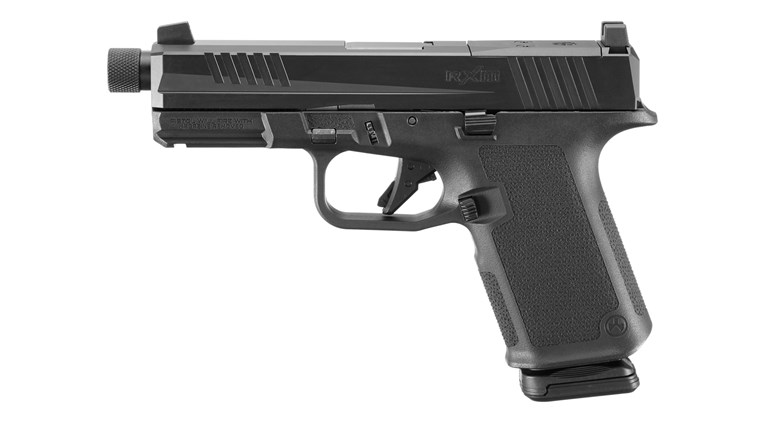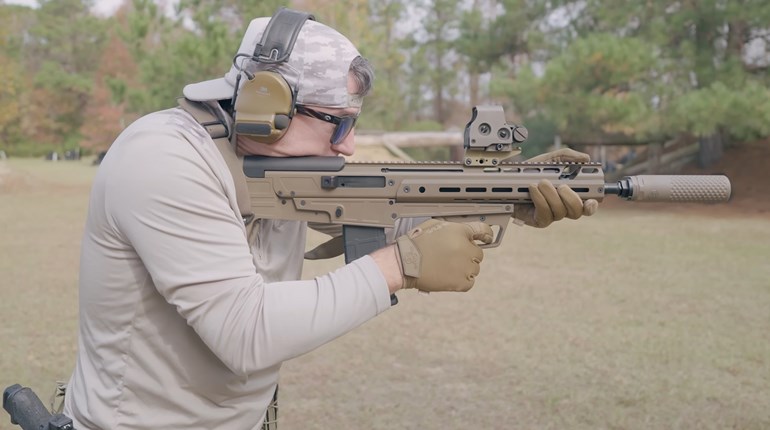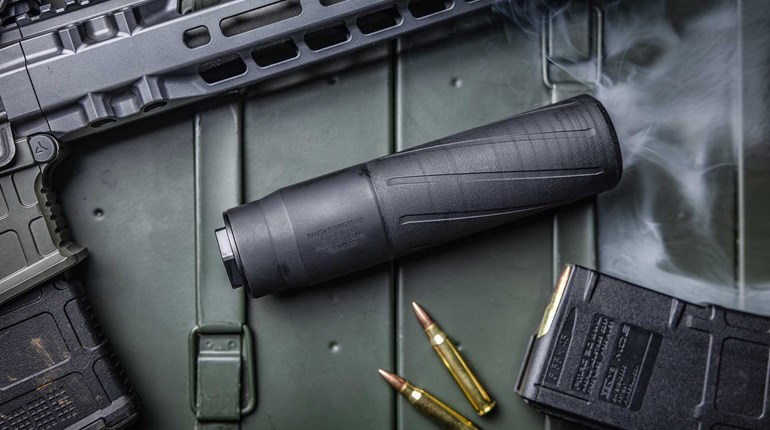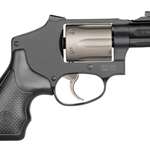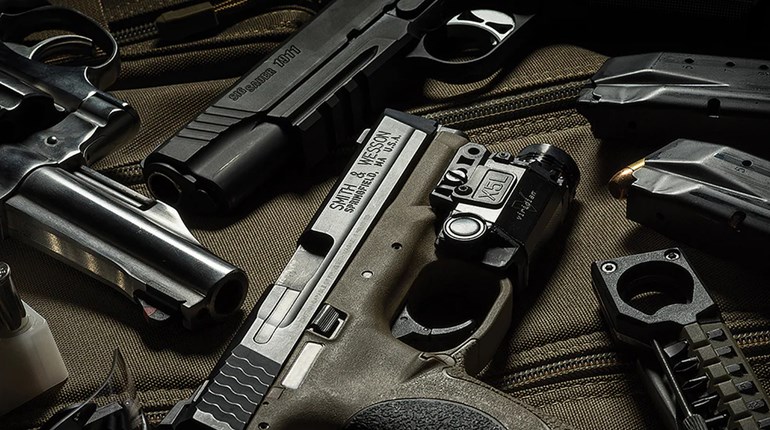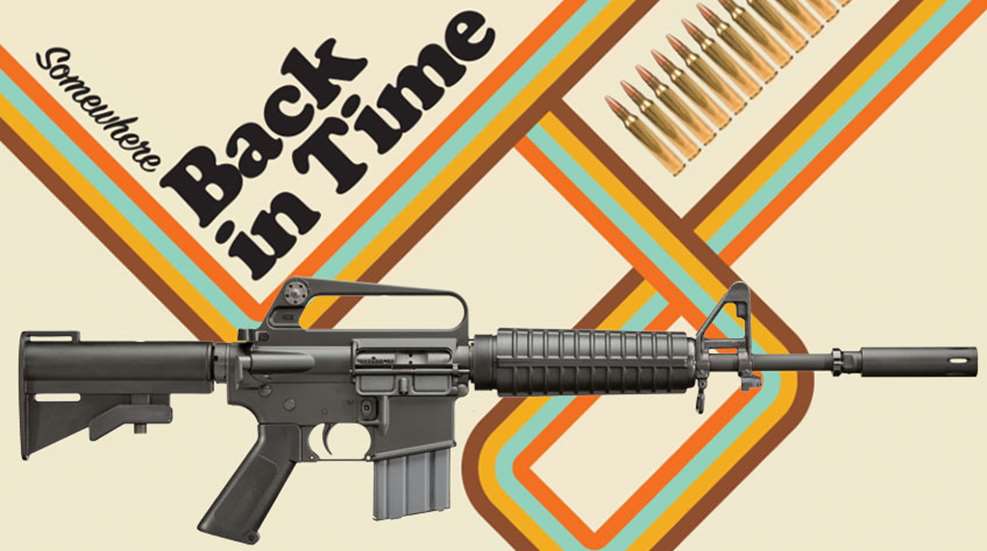
With the launch of its XBRN-177E2 AR-15 and other models, Brownells has stepped into the future by jumping back 50 years. Let me explain. There was a time when the only model AR-15 you could buy was an A1, which was pretty much like the Model T Ford—you could have any color you wanted, so long as it was black. The A1 rifle back then offered only a skinny, slow-twist barrel, a carry-handle upper, triangular plastic handguards, iron sights and a fixed stock. There really were no options. The later adoption of the A2 changed some of that, and by then Colt was making a few—a very few—models that weren’t straight-up A1 or A2 rifles and carbines.
But many of us wanted more, and different. Some shooters chopped the handle off and rebuilt uppers. Some even took A2 lowers, ground the contours back to A1, found A1 uppers to match and built models that had existed, but had never really been offered by Colt to those of us outside the armed services.
The world moved on. As time passed, the older models got rarer and rarer. It became common on an AR to have colors, camouflage and freefloat handguards with slots for accessories. Memories of the old days faded, but still some longed for the old models. Small companies started making bits n’ bobs of the old ones, so you could find what you needed and build one.
What was the lodestar, the apex of the Retro movement, as it was called? To me, it would be the XM-177, in its various versions; E1, E2, GAU-5, etc. Even when the M16A1 had been adopted, being pounds lighter than the M14 it replaced, end-users sought something even lighter and more compact. Colt responded with the XM-177, a carbine version of the M16A1 that had a seriously shortened barrel, a stock that telescoped and a bunch of problems—one of which was its extremely loud report. This was long before suppressors were common, and taking a 20-inch barrel, shortening it to 10.5 and using the same ammo made an already loud firearm even more so.

Colt solved that problem and the gas-system problem that came with it by installing a “moderator.” The idea was to tame muzzle blast with a something that wasn’t a silencer at the time (the ATF would later classify it as one). The real benefits were twofold: adding an extra inch to the barrel and installing the moderator put the bullet exit that much farther away from the shooter. These made the gas necessary to drive the system run a lot more consistently, and the carbine more reliable. In the process of its development, the XM went through a number of design and designation changes.
Want an XM-177? Well, you have to scrounge parts no more if you seek the E2 model. Brownells has jumped into the arena with a full assortment of retro offerings, in its (big surprise) Retro line. The object of our attention is the Brownells XBRN-177E2.
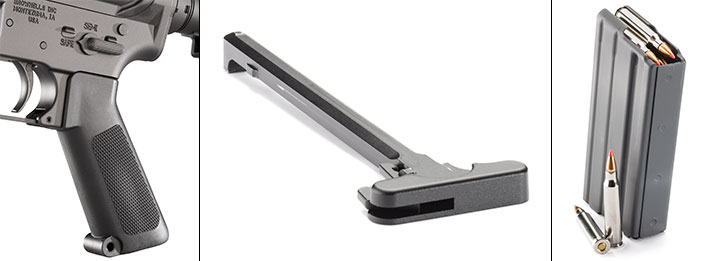
This AR is a clone of one of the early models of the carbine, but not the earliest. I have to give the company a big thumbs-up on just where it jumped in on the XM series, having built a few of the clones myself. The earliest versions, while historically and technically cool, have some annoying details. Brownells chose a model that had those details corrected.
The upper and lower receivers are a correct-contour A1 set, with the lower containing a full fence, not the partial, or slickside, of earlier models. The upper has an A1 rear-sight system and a forward assist, with the period-correct teardrop button. Both receivers are finished in the dark-gray anodizing, not the later, jet-black anodizing dye used with the adoption of the M16A2, when the full-on black anodizing became the standard.
The charging handle on the Brownells XBRN-177E2 is the A1 version, not the old triangular one. The carrier is a Parkerized M16 type—the full, heavyweight carrier. It contains a phosphate-finished mil-spec bolt, just as such a carbine would have had in the late ’60s or early ’70s.

The buttstock is comprised of a mil-spec tube with a telescoping, two-position stock (open or closed), with one minor change from its inspiration: Original XM-177 stocks were made of aluminum and were given a coating of vinyl acetate. Its finish was shiny, slick and just a little bit strange on your face. (Maybe it feels strange because it is so unfamiliar.) Perhaps the biggest deal is, the original stock was heavy. Brownells’ stock is better, and is the later-model stock made from a durable polymer and much lighter than the first-run versions. Also, the two-positions on the stock are period-correct. Having only open and closed as options may make it a bit less useful for those who prefer something in-between, but that’s the way they were back in the day.

It makes sense that the company chose to go with the original A1 grip and handguards on the Brownells XBRN-177E2. Handguards are round, ribbed and slim, with a single-layer heat shield inside, and the retaining ring is the period-correct flat type, not the delta ring of the A2. They are also short—there was no mid-length gas system available back then. If you are a fan of the “straight arm” fad of holding an AR, you will find the XBRN-177E2 more than a bit uncomfortable to shoot. The rest of us, however, will be fine.
The handguards culminate in a front-sight “A” frame to hold the A1 sight and work with the A1 rear sight. If you absolutely have to have a scope on your carbine, the carry handle has the neces-sary hole through which you stick the threaded, clamping shaft of the correct optic.
Inside the handguards is an authentically styled barrel in some of the important details, and a more modern one in the other important details. Lightweight and with a rifling twist of 1:12 inches, the barrel limits you to ammunition with light- to medium-weight bullets. You will not be happy with this carbine if you only have M855 ammunition (green tip) on hand to shoot, but bullets lighter than 62 grains will deliver fine accuracy.
Brownells could have gone with a 1:9 twist, or even a 1:7 twist, but I have to commend the company on this choice. There are plenty of choices—good practice, varmint and defensive loads—that will work properly in the 1:12 twist. Since that is the case, why change the “true-to-the-original” twist rate for something newer?
Barrel-wise, the Brownells XBRN-177E2 sports a 12.7-inch tube, with a flash hider pinned and welded to it to bring it just past the 16-inch minimum needed to keep it from being an SBR. This is only 1 inch longer in overall length than an actual XM-177E2, a minor concession to avoid the NFA paperwork of SBR status. The flash hider is proportioned to look like the original moderator, complete with the “grenade ring,” which was simply where the then-new grenade launcher clamped on to turn the handy, lightweight XM-177E2 of the time into a boat anchor—a boat anchor that threw grenades, of course. Alas, an M203 is not an option in the Brownells Retro line.
The flash hider on the Brownells Retro is just that: a flash hider. Originally, it sported a flash hider and moderator, one that didn’t do all that much in suppressing the muzzle blast of the M193 ammunition used at the time. It still wouldn’t, and because it was built like a suppressor, the ATF many years ago declared it to be one, so the verisimilitude of a period-correct moderator on the Brownells XM-177E2 is not available on a non-NFA-regulated firearm.

Historical accuracy is all well and good, but the proof is in the pudding. How did the XBRN-177E2 perform? The first thing to do is check fit, finish and dry-function. The fit of upper to lower was snug—without wobble, but not so tight that it had to be wrestled apart.
In function, the Brownells XBRN-177E2 was faultless. All loads tested functioned with 100-percent reliability, never failing to fire, extract or eject and when the last round was fired, to lock the carbine open.
Accuracy testing posed some problems as scope-mounting options are severely limited. This is due to the fixed carry handle necessitating mounting a scope using the hole in the carry handle. Lacking a Colt 3X scope of the period, or a base that bolts through the hole in the carry handle, you are not going to be putting optics on your Retro. Fortunately, I happen to have a Colt 3X scope, and it fit properly to the Brownells rifle. Unfortunately, this combination has the same problem as the originals: You do not have a cheek weld. The term I coined back then was “chin weld,” as you have only your jaw against the stock for aiming. Luckily, the recoil of .223 Rem./5.56 NATO is light enough that it isn’t painful, just a bit awkward.
In deference to the misty Colt 3X scope, its now half-century-old glass and thick reticle, I did my accuracy testing at a deferential 50 yards. I also did not press my luck, and used only bullets in the appropriate weight range—55 grains or lighter. Any accuracy failings you might perceive I blame on the wonky optics of the old scope and the chin weld I was able to gain. That said, with the iron sights, the Brownells XBRN-177E2 is a light, handy AR, and a pleasure to shoot. At 100 yards, the gongs at the gun club never stood a chance when I used the iron sights. The shorter barrel takes a bit of steam out of the cartridge, but not as much as the inch-or-more shorter SBRs and pistols a lot of shooters are enamored of these days.
Brownells has done more than just offer us a rifle or carbine from the past. In addition to offering faithful clones of rarities, the company has also reminded us of the origins of the AR system: a light, handy, accurate and just plain fun-to-shoot rifle or carbine with modest recoil. For fans of the platform, this is a welcome development.

Going Full Retro
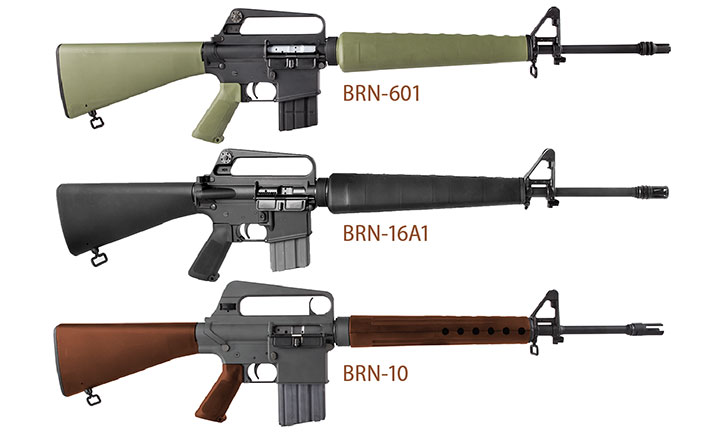
Brownells also offers a full range of other Retro offerings. There’s a BRN-16A1 model with the triangular-handguard rifle of Vietnam fame and all-black trim, forward assist and A1 flash hider. There is a clone of the original Air Force model, known as the BRN-601, with its green furniture, slickside lower and upper lacking a forward assist, topped off with a pronged flash hider. Lastly, there’s a transitional model, the BRN-16E1, with a partial-fence lower, chromed carrier, three-prong flash hider and forward assist. These are all like the original rifle, with a 20-inch, 1:12-inch-twist barrel. They all come with 20-round magazines, the standard of their time.
But there is also the big brother. This is the Brownells version of the AR10A (the BRN-10). A .308 Win./7.62 NATO rifle, it is the oldest Retro period piece of the line in terms of when the originals came out. It has the cocking handle on the top of the receiver, inside the carry handle. The receivers are slickside, with no fence and no forward assist, and the furniture is brown, as were the originals. —PS












